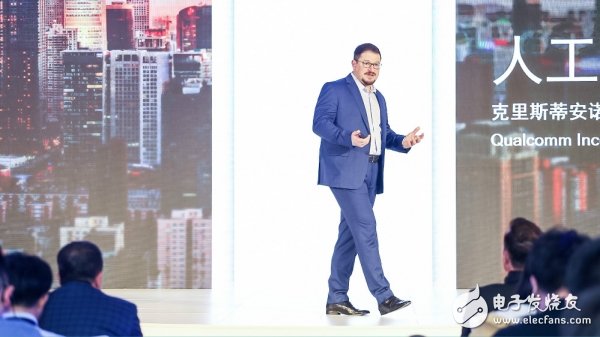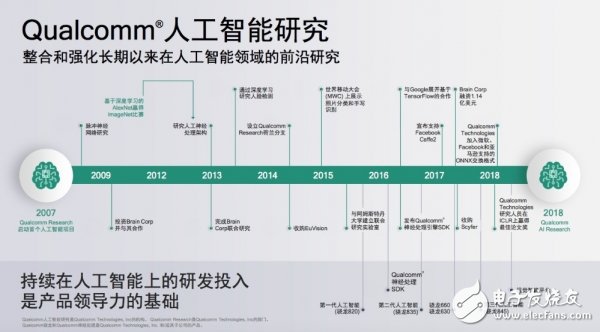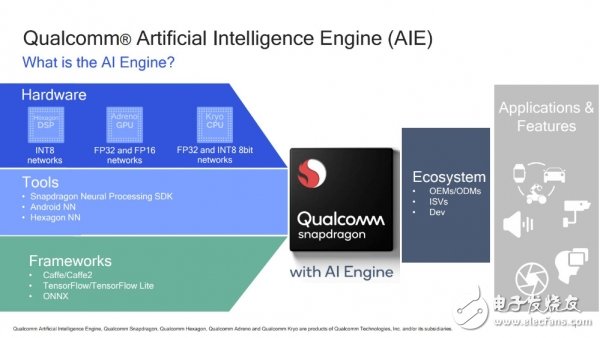In 2007, everyone used to call it the beginning of the mobile era, because that year, when the Internet broke out, social networks appeared, Google, Microsoft, and Facebook entered the public eye, and two things that changed the world occurred: one was Apple’s beginning of the year. The first generation of iPhone was released, and the second was the first generation of Snapdragon chips launched by Qualcomm in November of the same year. In 2007, Qualcomm Research began its first personal intelligence project to study pulsed neural networks for computer vision and motion control applications. At that time, Qualcomm might not have anticipated it. Ten years later, its pioneering mobile communications and labor. The smart direction is becoming the two biggest transformative forces in today's digital world. With regard to artificial intelligence, we have heard many magical stories. For example, AlphaGo defeated humans in Go, but with the power of these two changes, technology is subtly changing the mobile terminal. You may have found that the mobile phone is more beautiful, the sweeping robot is smarter, and the smart speaker knows you better... More importantly, this era of change has just begun, because of the upcoming 5G, The terminals around us can carry more computing power. Walking on the "edge" of intelligence Just as Meng Pu, chairman of Qualcomm China, recently mentioned at the Qualcomm Artificial Intelligence Innovation Forum: "Artificial intelligence is affecting more and more industries, and gradually expanding from the cloud to the terminal side, changing the way people live and work." In the past, many trainings on neural networks were done in the cloud or on a server-based basis. In recent years, the whole model has changed a lot. Some artificial intelligence training, execution and reasoning work, such as pattern matching, modeling detection, classification, recognition, detection, etc., have gradually shifted from the cloud to the terminal side, all edge terminals. Both will have machine learning capabilities. This means that data processing will be processed closest to the data source, complementing cloud processing. There are three main reasons driving this migration and evolution: First, data privacy. Consumers are extremely concerned about the privacy of personal data, the sharing of personal data should be better protected, and the security on the terminal side will be better. Second, performance. Complete the relevant processing and reasoning work on the terminal side, and maintain the operation and operation of ultra-low latency. If everything is done in the cloud, considering the round-trip time of the cloud processing to obtain information, there will be a great delay in terms of delay. challenge. Third, reliability. The terminal cannot completely rely on the cloud to complete all AI operations and processing. Once the connection is interrupted, the terminal will lose its own value. The value of terminal-side artificial intelligence is unquestionable, and Qualcomm is a mobile communication company, and the terminal side is the advantage. Gary Brotman, Director of Product Management at Qualcomm, mentioned in an interview that Qualcomm is a hardware platform and computing platform provider to ensure that the terminal-side AI can run efficiently from performance to battery life and achieve a better user experience. Focus on smart and 5G Qualcomm Wireless communication technology has seen a leap every decade, and Qualcomm has been hoping to change the way the world connects, computes and communicates for more than 30 years. Looking back at the history of Qualcomm, we first realized the digitization of mobile communications and ensured that a mobile phone was hand-held. Secondly, the calculation is redefined by the smartphone. Now, in the face of the new transformation that 5G and artificial intelligence will bring, Qualcomm is very excited. At the Qualcomm Artificial Intelligence Innovation Forum, Qualcomm President CrisTIano Amon used the word “expectation†more than once. To this change. Qualcomm President CrisTIano Amon According to Gartner's March 2018 data, by 2021, the commercial value of artificial intelligence will reach $3.3 trillion. Amon believes that trillions of terminals are connected to each other. To achieve scale, intelligence must be distributed to the wireless edge. Of course, this is not an easy task. Once machine learning is done at the edge, it means that multiple types of tasks need to be completed simultaneously in a limited environment. Therefore, to achieve artificial intelligence on the edge, you need to provide different solutions. 5G is an important solution. The ultra-high-speed, low-latency 5G network supports rapid connection to the cloud and unlimited storage and data in the cloud, while sensing, reasoning, and acting on terminals with processing power at the edge. In other words, in addition to providing unlimited data reading and high-speed connectivity to the cloud, the future 5G network will bring huge improvements in wireless edge computing capabilities. For example, the combination of AI and 5G allows smart terminals to achieve the same performance as PCs, such as enjoying the same VR experience as a dedicated gaming PC on a mobile phone. What's even more exciting is that from 2018 to 2022, the cumulative shipments of smartphones will exceed 8.6 billion units, and the scale of mobile terminals will bring huge potential to artificial intelligence platforms. There is no doubt that the huge scale of smartphones and the Shanghai IoT will bring artificial intelligence to trillions of connected terminals. This is why Qualcomm chose to transform artificial intelligence by extending intelligence to the terminal side, using 5G advantages to build processing power at the wireless edge, and enhancing application-oriented computing performance. As mentioned in the opening article, Qualcomm began research on artificial intelligence many years ago. At present, research has been applied to the product side – from the first generation artificial intelligence platform Snapdragon 820 to the third generation platform Snapdragon 845, Qualcomm mobile platform is ready for the 5G era. At the Qualcomm Artificial Intelligence Innovation Forum, Qualcomm AI Research was established to focus on artificial intelligence research under a unified architecture to accelerate the innovation of Qualcomm's artificial intelligence on the terminal side. It is worth mentioning that there is also a challenge in the terminal side artificial intelligence. It is not difficult to find that mobile terminals are driving the continuous evolution of engineering design. In the 4G era, we need to make mobile terminals comparable to the performance of PCs, while considering the shape design of the terminal. In the future, this will be the case. Artificial intelligence is needed to handle more concurrent applications and more machine learning scenarios. At the same time, efficient heat dissipation and shape design should be taken into consideration. Consumers will expect more than all-day battery life. In the future, there may be “unlimited storageâ€. "This requires high-speed data transmission while ensuring connectivity. In terms of terminal-side artificial intelligence workloads, its challenges include supporting intensive computing, continuously processing large and complex models, and complex concurrency." Sex, because these processes are done on the smartphone, so it will always be on and in real time. These challenges have set new requirements for terminal design, and at the same time have to trigger chip manufacturers and OEMs to think about how smart phones should implement artificial intelligence in the 5G era. In this regard, Amon emphasizes that Qualcomm is committed to bringing the ubiquitous intelligent experience into reality, focusing on two aspects: high-efficiency artificial intelligence and personalized artificial intelligence. Artificial intelligence will provide all the relevant information in the appropriate environment based on all the information about the user in the smartphone, or meet the needs of the user - this requires very efficient hardware, algorithm improvements, software tools and system-level solutions. This is also one of the key attributes of the Xiaolong platform. A few months ago, Qualcomm released the Snapdragon Artificial Intelligence Engine (AIE, AI Engine). In just a few months, AI Engine is integrated on different platforms. Now, Qualcomm continues to expand the artificial intelligence ecosystem. In terms of products, Qualcomm launched the Snapdragon 710 mobile platform, which uses an efficient architecture that supports artificial intelligence, integrates AI Engine, and has neural network processing capabilities. Kedar Kondap, VP of Product Management at Qualcomm, said: "The Snapdragon 710 aims to transform our customers' products into the ultimate personal assistants and enhance the daily experience of key consumers. For example, high-end camera features will benefit from high-speed AI processing on the terminal side. No need to sacrifice battery life." In terms of cooperation, Qualcomm and Chongqing Chuangtong (Thundercomm) jointly launched an AI development kit, TurboX AI Developer Kit, to provide developers with available artificial intelligence engines, artificial intelligence reference applications and models, such as object recognition, defect detection, Scene detection and pet identification, it will also adopt modular design to support extended AI and shooting functions; Qualcomm and Baidu cooperate to use AI Engine to promote Baidu PaddlePaddle open source deep learning framework through ONNX (Open Neural Network Exchange) exchange format The model is transformed and applied in the Qualcomm? éªé¾™? mobile platform; in addition, Qualcomm and Netease have a good cooperation, using AI Engine components to accelerate the realization of the real-life AR translation function on some Snapdragon platforms, this is the first time for this new feature. Implement the application on the Android platform. In other words, as long as you open a channel translator and point the phone camera at the text content you want to translate, you can realize the real-life AR translation of China, Britain, Japan and South Korea without taking photos or relying on the network or the cloud for processing. Amon said, "We hope to provide such computing power for every terminal equipped with the Snapdragon platform." In the future, Qualcomm will cooperate with many operators to build computing power at the edge of 5G networks and take advantage of 5G performance and low. Delays further release the potential for edge calculations. Amon also admitted that Qualcomm would not be able to do this without extensive industry cooperation.
Aluminum substrate is a metal-based copper clad laminate with good heat dissipation function. Generally, a single-sided panel consists of three-layer structure, which are circuit layer (copper foil), insulating layer and metal base layer,and are usually used in products that require heat dissipation, such as solar energy,Led light etc.
Metal Core PCB,FR4 PCB Board,Double-sided Aluminum PCB,Single Sided Board,Aluminum Based Circuit Board Huizhou Liandajin Electronic Co., Ltd , https://www.ldjpcb.com

